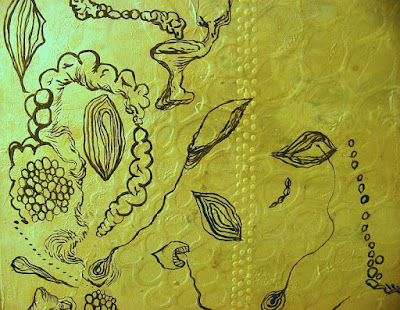So as I was working on this picture on which I painted all the texture and the dot patterns:
... I felt emboldened, for some reason, to start drawing all over it, using a fine point brush and airbrush paints:
I have an idea about where this all came from, though I don't know why it came forth today and not earlier. I've done a lot of automatic drawing in the last few years, some of it random, some of it clearly related to the personal narrative work. Mostly I felt able to combine figurative and non-figurative elements in prints, and artist's books, rather than in paintings.
Over Christmas, I read part of Xenophon's 'Anabasis', regarded as one of the greatest texts of the ancient Greek world. Without going into too much detail about the story, the main thing that stayed with me was the idea of the word 'Anabasis' which can be translated as 'journey to the interior'. Most of what I am trying to do in the studio ultimately is just that: a voyage to the interior of the self; an Anabasis.
And when you start on that voyage, you run into all sorts of unexpected things:
I'm thinking of adopting 'Anabasis' as the name for my next solo show.
 Subscribe to Praeterita in a reader
Subscribe to Praeterita in a reader
... I felt emboldened, for some reason, to start drawing all over it, using a fine point brush and airbrush paints:
I have an idea about where this all came from, though I don't know why it came forth today and not earlier. I've done a lot of automatic drawing in the last few years, some of it random, some of it clearly related to the personal narrative work. Mostly I felt able to combine figurative and non-figurative elements in prints, and artist's books, rather than in paintings.
Over Christmas, I read part of Xenophon's 'Anabasis', regarded as one of the greatest texts of the ancient Greek world. Without going into too much detail about the story, the main thing that stayed with me was the idea of the word 'Anabasis' which can be translated as 'journey to the interior'. Most of what I am trying to do in the studio ultimately is just that: a voyage to the interior of the self; an Anabasis.
And when you start on that voyage, you run into all sorts of unexpected things:
 |
| Closey-uppy picture of above painting |

